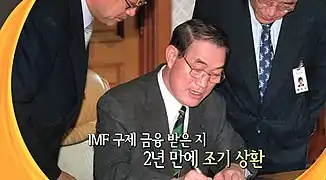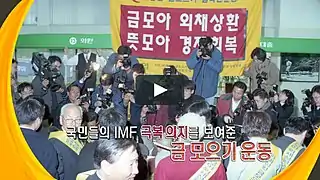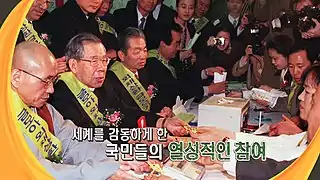| Gold-collecting campaign | |
 Korean citizens participating in the gold-collecting campaign. (English translation of the text on the screen: A gold gathering campaign showing the will of the Korean people to overcome the IMF) | |
| Korean name | |
|---|---|
| Hangul | |
| Hanja | |
| Revised Romanization | Geum Mo-eu-gi Undong |
| McCune–Reischauer | Kŭm moŭgi undong |
| The gold collecting campaign, from January to April 1998 | |
In South Korea, the gold-collecting campaign was a national sacrificial movement in early 1998 to repay its debt to the International Monetary Fund. At the time, South Korea had about $304 billion in foreign-exchange debt. The campaign, involving about 3.51 million people nationwide, collected about 227 tons of gold[1] worth about $2.13 billion.[2]
Background
On July 2, 1997, Thailand changed its 13-year-old fixed exchange-rate system. As the exchange rate changed, the price of Thai baht in the foreign-exchange market fell. This was a cause of the East Asian financial crisis.[3] On May 21 of that year, the IMF was asked to provide liquidity-adjustment funds.[3] At the time, the real cause of the foreign-exchange-liquidity problem was controversial.[3] The domestic foreign-exchange market lacked dollars, the South Korean won exchange rate increased, and some financial institutions were unable to repay their foreign debts.[3] Foreign borrowing by financial institutions was blocked, making it difficult to repay a short-term external debt of $30 billion and a long-term external debt of $45 billion.[3] The Kim Dae-jung government persuaded the South Korean people to participate in the Gold-collecting campaign to overcome the nation's debt to the International Monetary Fund. The campaign was reminiscent of the previous "Repay debt movement" or "Korean production movement" in 1907.[4][5][6] A "one-dollar collection campaign" received little attention. The Korean Broadcasting System proposed a "gold-gathering movement" beginning on January 6, 1998, which received nationwide attention.[3]
Campaign
The nationwide gold-collecting campaign was announced on December 25, 1997, when KBS1 first reported the proposal.[7] On January 5, 1998, KBS1 began the campaign with the Housing Bank.[7] The campaign was developed by a number of media organizations following the KBS report. Gold was received by six banks: Housing Bank, Nonghyup, Kookmin Bank, Korea Exchange Bank, Saemaeul Bank, and Industrial Bank. The campaign had two facets: KBS's "love of nation" and the MBC TV and civic-organization "foreign-debt repayment".[7]
The campaign was conducted from January 5 to April 30, 1998. On January 5, 1998, 3,314 kilograms (7,306 lb) of gold was received in 44,748 consignments. On January 5 the number of participants exceeded 500,000, doubling (to one million) by January 15.[8] The first KBS campaign ended on January 31, with 1,669,555 participants, and the second campaign was held from February 5 to February 21.[8] A total of 314,515 people participated in the second campaign, contributing 19,326 kilograms (42,607 lb). The foreign-debt-repayment campaign led by MBC and consumer and civic groups ran from January 12 to March 14. It had 884,000 participants, and collected 49,603 kilograms (109,356 lb).[8]
The gold-collecting campaign was most active in January, with participation slowing in February.[9] The Ministry of Commerce, Industry and Energy estimated the total number of participants at 3.51 million, with 30 percent of the gold collected during the campaign's first 10 days.[9] Participation continued during February, and MBC and the National Agricultural Cooperative Federation led their campaign until March 14. Although the foreign-debt-repayment was extended until April 30, participation decreased significantly after March 14.[9]
Campaign participants were expected to receive a confirmation letter from a professional appraiser for 24-karat gold. After export, its dollar value was determined at the exchange rate and the international gold price and the value later returned in won.[10]
About 225 tons were raised: 165t in January 1998, 53t in February, 5t in March, and 0.8t in April.[11] An equivalent of $2.17 billion was collected, increasing the amount of gold held by the Bank of Korea by 10 to 20 times.[11]
The press disseminated news about the gold-collecting campaign to all social groups, encouraging them to participate. After March, news reports indicated that the campaign hoped to overcome the foreign-exchange crisis and encouraged conformity.[11] The media reported on the participation of companies such as Samsung and Daewoo and individuals such as Lee Jong-bum, President Kim Dae-jung and Lee Kun-hee. They also encouraged participation in the campaign by the general public; Chung Sung-hwan donated the equivalent of ₩500,000.[12]
After March 1998, when the campaign was completed, its performance was reported. The report noted the fact that country could overcome its economic crisis primarily by collecting gold.[13] The campaign emphasized voluntarism and patriotism, and was developed for convenient participation.[14]
Results
At the end of February 1998 five financial institutions (including the Housing Bank and Kookmin Bank) stopped collecting gold, and the NACF ceased its involvement at the end of April.[15] The amount of gold totaled about $1.82 billion in foreign currency.[16] An average of 65 grams (2.3 oz) per household was collected.[15] Twenty-one thousand people contributed 177 kilograms (390 lb) of gold, and 1,735 people consigned 131 kilograms (289 lb) in the form of government bonds.[16] The Housing Bank (KBS-Daewoo) collected the most gold (364t), followed by Nonghyup (MBC-Samsung, 48.23t), Kookmin Bank and Saemaeul Bank (SBS-LG, 33.68t), Korea Exchange Bank (4.25t) and Industrial Bank of Korea (1.98t).[16] The campaign repaid the $19.5 billion in IMF-backed debt in August 2001, three years ahead of schedule.[17]
Evaluation
The gold-collecting campaign is regarded as a driving force for a people to overcome a foreign-exchange crisis.[18] According to a 2017 survey conducted by the Korea Development Institute to assess the impact of the 1997 financial crisis, 54.4 percent of respondents cited national unity as the driving force behind recovery; 42.4 percent noted the IMF crisis, and 15.2 percent cited restructuring and reform efforts.[18]
Contemporary news articles emphasized voluntary participation to overcome a national crisis and shame associated with not self-sacrificing for the country.[19] Emphasizing the patriotism of the Korean people, it blurred the real reasons for the economic crisis with emotional appeals.[19] After the campaign ended, restructuring became an issue.[19] The collective memory of the campaign was used to justify chaebols, labor flexibility, over-consumption, and nostalgia for the Park Chung-hee regime; critical reflection on the event was ignored.[19]
Gallery
 The gold-collecting campaign
The gold-collecting campaign Korean citizens turning in gold
Korean citizens turning in gold Video of the campaign: Gold-collecting campaign in South Korea to overcome the debt to the IMF.
Video of the campaign: Gold-collecting campaign in South Korea to overcome the debt to the IMF. Repayment to IMF, two years early (English Translation about the text on the screen: "Dedicated participation of the people who impressed the world")
Repayment to IMF, two years early (English Translation about the text on the screen: "Dedicated participation of the people who impressed the world")
References
- ↑ 조, 문호 (2008-10-18). "'전국민 달러 모으기' 애국인가 망국인가". 매일신문.
- ↑ 헤럴드경제 (2013-05-03). "[위크엔드] 換亂극복 '눈물의 금모으기'…한국은 울고, 세계는 감동했다" (in Korean). Retrieved 2018-06-25.
- 1 2 3 4 5 6 Gun, Park (2007). "A Study on the Social Construction of Collective Memory: Focusing on NRC and CGC". Culture & Society (in Korean). 2. ISSN 1975-7239.
- ↑ Song, Jesook (2009-08-18). South Koreans in the Debt Crisis: The Creation of a Neoliberal Welfare Society. Duke University Press. ISBN 978-0822390824.
- ↑ "Rok President Kim Dae-Jung's Keynote Address on the Korean Economy". The Journal of East Asian Affairs. 12 (2): 620–626. 1998. JSTOR 23255888.
- ↑ https://www.globalintergold.com/gold-news/read/two-case-studies-how-gold-saved-india-and-south-korea
- 1 2 3 이순영 (2004). 국가위기시 상징적 통합에 대한 연구 : 금모으기 운동 (1998) 과 국채보상운동 (1907-1908) 의 담론분석 (A Study on the Symbolic Integration at the Time of State Crisis – Discourse Analysis on the Collecting Golds Campaign (1998) and the Compensation Movement for National Debt (1907-1908)) (Thesis) (in Korean). 서울대학교 대학원.
- 1 2 3 이순영 (2004). 국가위기시 상징적 통합에 대한 연구 : 금모으기 운동 (1998) 과 국채보상운동 (1907-1908) 의 담론분석 (A Study on the Symbolic Integration at the Time of State Crisis – Discourse Analysis on the Collecting Golds Campaign (1998) and the Compensation Movement for National Debt (1907-1908)) (Thesis) (in Korean). 서울대학교 대학원. p. 24.
- 1 2 3 이순영 (2004). 국가위기시 상징적 통합에 대한 연구 : 금모으기 운동 (1998)과 국채보상운동 (1907-1908)의 담론분석 (A Study on the Symbolic Integration at the Time of State Crisis – Discourse Analysis on the Collecting Golds Campaign (1998) and the Compensation Movement for National Debt (1907-1908) (Thesis) (in Korean). 서울대학교 대학원. p. 25. hdl:10371/22125.
- ↑ "㈜대우.주택은행.고려아연, 장롱속 金 수집운동 (Daewoo Corporation, A housing bank, Goryeo zinc. A campaign to collect gold in a wardrobe)". 연합뉴스(Yonhap News). 1997-12-30.
- 1 2 3 천 (Cheon), 혜정 (Hyejung) (Fall 2017). "IMF 외환위기 기억의 사회적 구성 - 조선일보의 '금 모으기 운동' 기사를 중심으로 (Social Memory of IMF's Bailout in 1997 : Recollection of 'gold-collection campaign')". 사회과학연구논총(Ewha Journal of Social Sciences). 33 (2): 371–372.
- ↑ 천 (Cheon), 혜정 (Hyejung) (Fall 2017). "IMF 외환위기 기억의 사회적 구성: 조선일보의 '금 모으기 운동' 기사를 중심으로 (Social Memory of IMF's Bailout in 1997: Recollection of 'Gold-Collection Campaign')". 사회과학연구논총 (Ewha Journal of Social Sciences). 33 (2): 372. SSRN 3135100.
- ↑ 천 (Cheon), 혜정 (Hyejung) (Fall 2017). "IMF 외환위기 기억의 사회적 구성: 조선일보의 '금 모으기 운동' 기사를 중심으로 (Social Memory of IMF's Bailout in 1997: Recollection of 'Gold-Collection Campaign')". 사회과학연구논총(Ewha Journal of Social Sciences). 33 (2): 373.
- ↑ 천(Cheon), 혜정(Hyejung) (Fall 2017). "IMF 외환위기 기억의 사회적 구성: 조선일보의 '금 모으기 운동' 기사를 중심으로 (Social Memory of IMF's Bailout in 1997: Recollection of 'Gold-Collection Campaign')". 사회과학연구논총(Ewha Journal of Social Sciences). 33 (2): 374.
- 1 2 조 (Cho), 준상 (Junsang) (1998-05-21). "본전도 못건진 금모으기운동 (The gold collecting campaign that can not find the principal)". 한겨례21 (Hankyoreh 21).
- 1 2 3 "금모으기 운동 2백25t 수집...외화가득 18억달러 (Collecting gold 225 tons through gold collecting campaign ... Foreign exchange is worth $ 1.8 billion)". 연합뉴스 (Yunhap News). 1998-03-14.
- ↑ "EBS '인터뷰 대한민국'- IMF 20년, 98년생 청춘에게 대한민국의 현재는? (EBS 'Interview Korea' - IMF 20 years, How is the present situation of Korea to youth born 1998?)". 미디어스 (Mediaus). 2018-01-28.
- 1 2 조(Cho), 영주(Young-ju) (2017-11-14). "국민 10명중 6명 "외환위기, 삶에 부정적 영향"…비정규직 등 심화 (6 out of 10 Koreans "Foreign Currency Crisis, Negative Impact on Life" ... Deepening of irregular employment)". 아시아경제(Asian Economy).
- 1 2 3 4 Cheon, Hyejung (2017-10-31). "Imf 외환위기 기억의 사회적 구성: 조선일보의 '금 모으기 운동' 기사를 중심으로 (Social Memory of IMF's Bailout in 1997: Recollection of 'Gold-Collection Campaign')". Rochester, NY. SSRN 3135100.
{{cite journal}}: Cite journal requires|journal=(help)